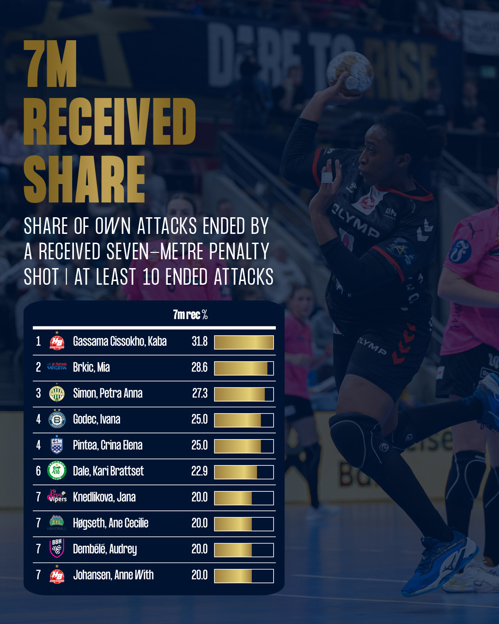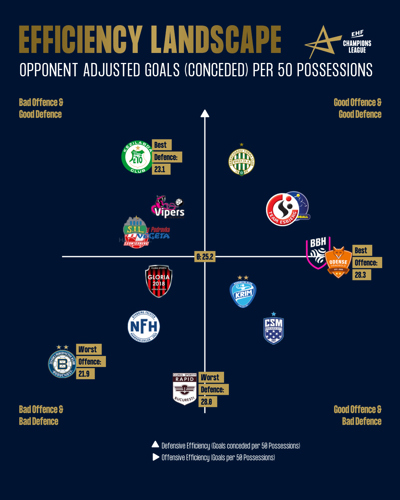Earlier this month Petra Simon won the EHF Excellence Award 2024 for Young Player of the Season. In 2023/24, her debut season in the EHF Champions League, the 20-year-old centre back took an important role in FTC-Rail Cargo Hungaria’s back court, scoring 2.2 goals per match. In 18 games she ended 10.6 per cent of her team’s attacks by shooting from the field, receiving a seven-metre penalty throw or turning the ball over. Just three other players — Katrin Klujber, Emily Bölk, and Andrea Lekic — had a higher offensive responsibility for FTC.
This season, however, things have changed a bit. Simon’s offensive responsibility has dropped, mainly because FTC strengthened their back court with new arrivals Daria Dmitrieva, Valeriia Maslova, and Orlane Kanor in the off-season, as now seven players are sharing playing time on court.
More received penalty shots, less turnovers
Nevertheless, her statistics are very interesting this season. With the reduced playing time not just her scoring, but almost all other stats have decreased as expected as well. Being awarded penalty shots, however, is an exception. After receiving 0.3 seven-metre shots per game last season, she increased that number to 0.4 this season.
From all possessions she ended for FTC this season, 27.3 per cent led to receiving a penalty. Of all 182 players in the EHF Champions League that ended at least 10 attacks for their team, only two line players have a higher share. Last season, she was average with 5.4 per cent.

Interestingly, with the increased share of received seven-metre shots, it’s not the shot attempts that have decreased significantly but her turnovers. Just 9.1 per cent of the possessions she ended for FTC this season have been turnovers — the sixth-best rank among all 106 back court players with an offensive responsibility of at least 2.0 per cent. Last season, she had a 25.0 per cent share of turnovers.
Currently things are going very well for FTC. They have improved significantly on both sides of the court in comparison to last season. Defensively, they are the second-best team with opponent adjusted 23.0 goals conceded per 50 possessions, an improvement of 2.7. In attack, they have improved by 1.6 and are in fifth place with opponent adjusted 26.5 goals per 50 possessions. This resulted in seven wins from eight games, so not much reason for coach Allan Heine to change a lot.
Using these statistics that are adjusted for possessions played is significantly more meaningful than just the raw number of goals (conceded), because it makes the teams comparable. The raw number of goals is not only influenced by efficiency, but also by the number of possessions — whether a team and their opponents play rather fast or slow. Since a game has roughly 50 possessions on average (56.9 this season), the values here are calculated on 50 possessions so that they roughly reflect those of a game.
In addition, the numbers are adjusted for opponent strength, which makes a comparison between teams fairer, because not every team played the same opponents. The adjustment is done by calculating how many goals (conceded) per 50 possessions would be expected for each game and team by the number of goals the opponents scored and conceded per 50 possessions in their other games. The so-called ‘garbage time’ when the game is already decided, is also filtered out. The differences to the actual goals scored and conceded can then be added to the goals scored or conceded per 50 possessions to have an adjusted rating.

Shooting improvement
Petra Simon can still improve on her shooting efficiency. Last season, the MVP of the W19 EHF EURO 2023 scored 47.4 per cent of her 4.3 non-penalty attempts per game; this season she currently stands at 42.9 per cent.
Diving deeper into her shots, it is striking that she shoots from shorter distance in the current season. Excluding seven-metre penalty shots, direct free throws, first-wave counterattacks, and shots on the empty net, she has shot from an average of 7.3 metres to the middle of the goal last season; this season it is 7.0 metres.
Especially her shots from last season have shown that she also repeatedly looks for breakthroughs on the right, where she can often be pushed wide, which is of course impractical for a right-hander.
She also proved to be a reliable shooter from distance last season. Seven of her 14 attempts from more than 8.5 metres were successful. If only attempts from a central position are taken into account, it’s seven out of 11, i.e. a strong 63.6 per cent. This season, she has not attempted a shot yet from more than 8.5 metres.
The data from the current season should of course still be treated with caution, as she has only attempted seven shots so far. So, everything can change quickly after a couple of more games. But the shorter average shot distance and the increase in received seven-metre penalty throws are indicators that she is looking for more attempts from closer distance which, in turn, should lead to an even better shooting percentage.
While FTC resume their EHF Champions League campaign in January 2025, Petra Simon is expected to showcase her skills as one of the main assets for co-hosts Hungary at the Women’s EHF EURO 2024, which starts next week.
More from data analyst Julian Rux can be found at Handballytics.de. There you can read his latest articles, in which he analyses all kinds of handball topics from new, data-based perspectives. You can also find him on Instagram, Bluesky, Threads and WhatsApp channels.









